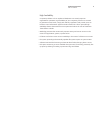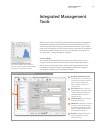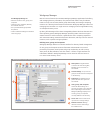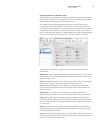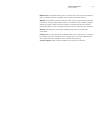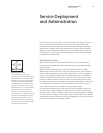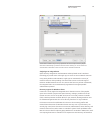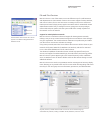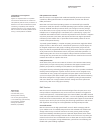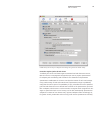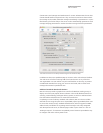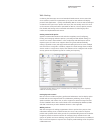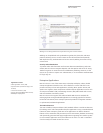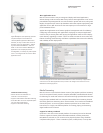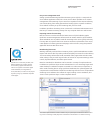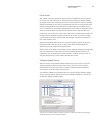17
Technology Overview
Mac OS X Server
File system access controls
Mac OS X Server v10.4 supports both traditional UNIX le permissions and access
control lists, o! ering administrators an exceptional level of control over le and
folder permissions.
Most UNIX- and Linux-based operating systems are constrained by the UNIX le
permissions model, also known as Portable Operating System Interface (POSIX) per-
missions. Standard UNIX le permissions allow you to assign one access privilege
to the le’s owner, one to a group, and one to everyone on the network. Access by
multiple users or multiple groups is not allowed, nor is ownership by a group. The
traditional UNIX model also lacks some other important le access features. It supports
only three permissions (read, write, and execute) and does not support permission
inheritance, which enables new or copied les to automatically inherit the access
controls of the parent directory.
To provide greater exibility in complex computing environments, Apple has added
support for ACLs in Mac OS X Server v10.4. With le system ACLs, any le object can
be assigned multiple users and groups, including groups within groups. Each le
object can also be assigned both allow and deny permissions, as well as a granular
set of permissions for administrative control, read, write, and delete operations. For
added security, Mac OS X Server now supports a le permission inheritance model,
ensuring that user permissions are inherited when les are moved to the server and
rewritten when les are copied to the server.
CUPS print services
At the heart of the print services in Mac OS X Server is the Common UNIX Printing
System (CUPS), an open source printing architecture that supports standard cross-
platform print protocols, including IPP, LPR, SMB/CIFS, and AppleTalk PAP.
Using Open Directory and Workgroup Manager, Mac OS X Server provides centralized,
directory-based management of printer resources. Printers can be assigned to any
combination of users, groups, and computers, and print quotas can be enforced on
a per-user and per-queue basis. Flexible queue management and remote monitoring
tools allow management of high-volume, cross-platform printing for Mac, Windows,
and Linux clients from a single, intuitive interface. Settings and access policies are
stored in any LDAP server using Open Directory.
Mail Services
Mac OS X Server combines several robust technologies from the open source com-
munity to deliver comprehensive, easy-to-use mail server solutions. Full support for
Internet mail protocols—Internet Message Access Protocol (IMAP), Post O" ce Protocol
(POP), and Simple Mail Transfer Protocol (SMTP)—ensures compatibility with standards-
based mail clients on Mac, Windows, and Linux systems. With support for thousands of
users per server and no per-user licensing fees, these high-performance mail services
o! er signi cant cost savings for small organizations and large enterprises alike.
Core mail services
Mac OS X Server uses the high-speed Post x server for SMTP messaging and the
Cyrus mailbox server for scalable, enterprise-class POP and IMAP mail. Flexible mail
storage makes it easy to scale the mail server to meet growing needs, and high-
performance Berkeley DB indexing ensures continued responsiveness when clients
access their mail, delete messages, and move les on the mail server. To protect your
network mail services from unauthorized access or abuse, Mac OS X Server includes
built-in SSL/TLS encryption, strong authentication, junk mail and virus ltering, and
exible mail quota handling capabilities.
Compatibility in heterogeneous
environments
Apple’s ACL implementation is compatible
with the POSIX 1003e draft. This enables full
interoperability with the native permissions of
Windows Server 2003 and Windows XP, while
maintaining compatibility with traditional
UNIX le permissions. Such versatility makes
Mac OS X Server the ultimate platform for le
sharing in mixed-platform work ows.
Mail services
• SMTP (Post x)
• POP and IMAP (Cyrus)
• Berkeley DB for indexing
• SSL/TLS encryption (OpenSSL)
• Junk mail ltering (SpamAssassin)
• Virus detection (ClamAV)
• Mailing lists (Mailman)
• Webmail (SquirrelMail)



